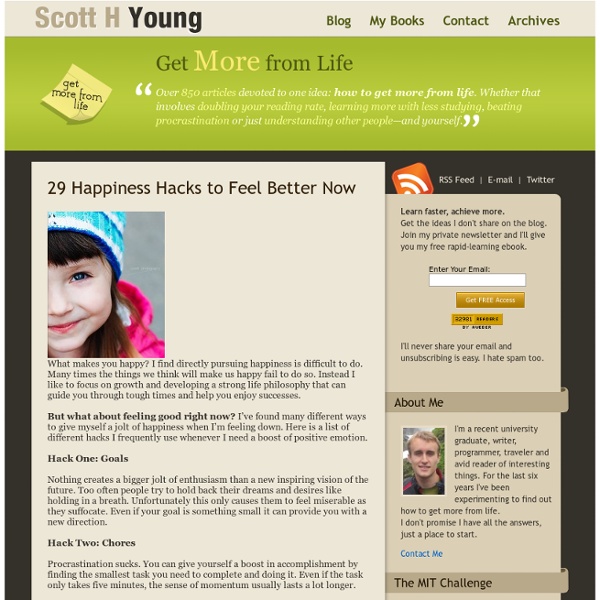How to become an early riser
By Leo Babauta I’ve found that waking early has been one of the best things I’ve done as I’ve changed my life recently, and I thought I’d share my tips. I just posted about my morning routine, and thought you might like to know how I get up at 4:30 a.m. For many years, I was a late riser.
Simple Living Manifesto: 72 Ideas to Simplify Your Life
“Simplicity is the peak of civilization.” – Jessie Sampter By Leo Babauta A simple life has a different meaning and a different value for every person. For me, it means eliminating all but the essential, eschewing chaos for peace, and spending your time doing what’s important to you. It means getting rid of many of the things you do so you can spend time with people you love and do the things you love. It means getting rid of the clutter so you are left with only that which gives you value.
7 stupid thinking errors you probably make
The brain isn’t a flawless piece of machinery. Although it is powerful and comes in an easy to carry container, it has it’s weaknesses. A field in psychology which studies these errors, known as biases. Although you can’t upgrade your mental hardware, noticing these biases can clue you into possible mistakes.How Bias Hurts You If you were in a canoe, you’d probably want to know about any holes in the boat before you start paddling. Biases can be holes in your reasoning abilities and they can impair your decision making.
Nature Gave Us Four Kinds of Happiness
Happiness is just a neurochemical spurt. Four different brain chemicals create happy feelings, and you need all of them to feel good. You miss out when you rely on one or two old familiar ways of triggering your happy chemicals. You can enjoy a balanced happy chemical diet if you know the distinct kind of happiness each brain chemical evolved for. Endorphin happiness is triggered by physical pain.
How to start your day at 5:00 AM
I have been an early-riser for over a year now. Monday through Friday I wake up at 5:00 AM without hitting the snooze button even once. I never take naps and rarely feel tired throughout the day.
List of Values
The following list of values will help you develop a clearer sense of what's most important to you in life, as explained in the article Living Your Values. Simply print out this page, mark the values which most resonate with you, and then sort your list in order of priority. As you scan the values list below, you may find that while most values have little or no significance to you (and some may even seem negative to you), there are those values that just jump out and call to you, and you feel, "Yes, this value is part of me." This values list is merely a guide. It is lengthy and contains many synonyms but is certainly not exhaustive, so feel free to add unlisted values to your own list as well. Steve RecommendsHere are my recommendations for products and services I've reviewed that can improve your results.
The Gentle Art of Saying No
It’s a simple fact that you can never be productive if you take on too many commitments — you simply spread yourself too thin and will not be able to get anything done, at least not well or on time. But requests for your time are coming in all the time — through phone, email, IM or in person. To stay productive, and minimize stress, you have to learn the Gentle Art of Saying No — an art that many people have problems with. What’s so hard about saying no?
33 Movies To Watch When You're Sad, Glum Or Bummed Out
We all have days that don’t feel quite right. Maybe you’re bored, sick or lethargic. Perhaps you just got some bad news that has left you feeling slack-jawed & useless. Maybe you’re worried about your sister, or fighting with your husband.



